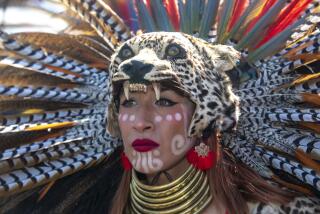A Celebration of Pride and Roots : As African American Community Gathersto Observe Kwanzaa,It’s a Time to LookAhead--and to Reflect
- Share via
SANTA ANA — Pam Coffey hasn’t been able to keep kinara sets, used by African Americans who celebrate the holiday of Kwanzaa, on the shelves this year.
Kwanzaa is a seven-day observance, rooted in African tradition, at year’s end when families reflect on the past year and focus on nguzo saba , seven principles that will help them lead prosperous lives in the upcoming year.
Two weeks ago, Coffey had 40 kinara sets in her Images shop. Tuesday, she had “one on display and not even a whole set behind the counter,” she said. “You get a few families celebrating, and they’ll tell someone and they’ll tell someone else. Last year, I ordered 15 and couldn’t sell all of them.”
Kwanzaa, which means “first fruits” in Swahili, is celebrated in homes and community centers from Dec. 26 through Jan. 1.
“Kwanzaa is also a deep respect for our ancestors,” said Willia Edmonds, the organizer of a celebration from 1 to 4 p.m. Saturday at the Bowers Museum of Cultural Art in Santa Ana.
“Our ancestors were the models of ethical life, service and social achievement to the community,” Edmonds said. “For us to honor our ancestors is for us to honor our roots and lineage.”
A candle-lighting ceremony is a large part of the festivities. Kinara sets include a candleholder, seven candles, a unity cup, a flag, a mat and a booklet on Kwanzaa.
The candleholder is the set’s centerpiece, symbolizing African ancestry.
The candles--one black, three red and three green--represent the principles of umoja (unity), kujichagulia (self-determination), ujima (collective work and responsibility), ujama (cooperative economics), nia (purpose), kuumba (creativity) and imani (faith).
Each day of Kwanzaa, a different candle is lit, starting with the black, and alternating from red to green. Black symbolizes the people, red, the continuing struggle, and green, the future.
The cup symbolizes unity and is passed around to each celebrant to drink from.
The flag was created for people of African descent by Pan-African leader Marcus Garvey. The red bar stands for the struggle for freedom, the black for unity and the green for the future.
Mikeka , the name for the mat that the kinara rests on, represents the foundations that community and family are built on.
Kwanzaa was created in 1966 by Maulana (Ron) Karenga, the black studies chair at Cal State Long Beach. It is a non-religious holiday in which traditional African clothing is typically worn to gatherings during the week. African music, dance and food are also plentiful.
Though too late to order more ceremonial sets, Coffey urges people who want them for next year to start looking for them early in November.
“We’re just starting to learn more about it,” said Renee Mitchell, 36, who bought a set from Images in 1993. “I think the unity of the black family, the pride and the structure it teaches helps us identify who we are as black people.”






